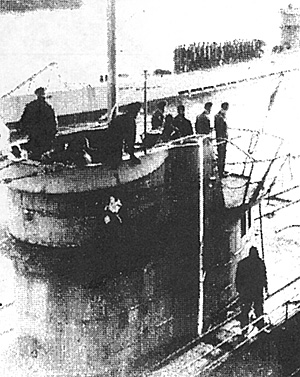 U-126 in Lorient.
U-126 in Lorient.
The US NAVY ARMED GUARD first became organized during WW I when Allied and American shipping was being attacked and sunk by the enemy in wartime. It was necessary guns be put on ships for protection, and the NAVY was then called on to furnish gun crews for these weapons. These men were known as the USN ARMED GUARD. Their main purpose was to maintain the guns and ammunition, protect the ship, the ship's crew and the cargo from the enemy with orders to stay aboard the ship and fire the guns as long as the ship was afloat. This was to keep the enemy from crippling the ship, then boarding it for provisions they needed to stay on patrol longer.
The ARMED GUARD served on 384 ships during World War I. This was a small number compared to the 6,236 ships they served on during World War II. The ARMED GUARD also consisted of officers in charge of the crew with radiomen and signalmen operating all transmission of codes and messages. The ARMED GUARD was deactivated after WW I.
With the war in Europe spreading over boundaries of neighboring countries and the horizon of war imminent, measures were being taken to man the ships again since the ALLIES had lost many from 1939 until we were drawn into the war with the bombing of Pearl Harbor on December 7, 1941. The merchant M/S CITY OF RAYVILLE was the first victim of who would, one year later, be our greatest enemy, for it struck a German mine that had been laid some 12 months previously at the western entrance of Bass Strait, six miles off Cape Otway Australia, claiming the life of one merchant seaman. He was the first of over 6,000 of the merchant crew to lose their lives during WW II.
Even though the ALLIES were having a lot of ships sunk during the 1940 - 1941 era, Congress could not authorize placing guns aboard the cargo ships due to the 1939 Neutrality Act, Section 6. This Act prohibited the arming of American merchant vessels during the existence of a Proclamation of a STATE OF WAR between foreign states or countries. It was not until the Act of November 17, 1941 (55 STAT.764), Section 2 of the Neutrality Act that repealed Section 6 before steps were enacted to arm the vessels and even before then, five more merchant ships were sunk before December 1941.
They were:
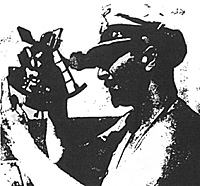 the SS ROBIN MOOR that was torpedoed and shelled by the Germans on May 21, 1941 700 miles off the west coast of Africa with no loss of life.
the SS ROBIN MOOR that was torpedoed and shelled by the Germans on May 21, 1941 700 miles off the west coast of Africa with no loss of life.
Metzler with sextant.
(HARRY'S NOTE - SS ROBIN MOOR was stopped by U-69 under Kplt Jost Metzler and searched, in accordance with the PRIZE REGULATIONS, then sunk after the crew was safely off.)
SS STEEL SEAFARER was sunk September 5, 1941 by German bombers in the Gulf of Suez with its lights on and a large American flag on the side. No crew were lost.
SS LEHIGH was torpedoed October 19, 1941 by the Germans with four slightly injured. (HARRY'S NOTE - LEHIGH was sunk by U-126 under Kplt Ernst Bauer).
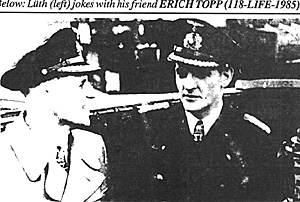 Luth (left) jokes with his friend ERICH TOPP (118-LIFE-1985).
Luth (left) jokes with his friend ERICH TOPP (118-LIFE-1985).
SS ASTRAL was sunk by a German sub on December 2, 1941 with a crew of 37; no survivors. (HARRY'S NOTE - ASTRAL was sunk by U-43 under FKPT Wolfgang Luth).
SS SAGADAHOC was sunk December 3, 1941 with the loss of one merchant seaman.
(HARRY'S NOTE - SAGADAHOC was stopped by U-124, the EDELWEISSBOOT, under Jochen Mohr and searched in accordance with the PRIZE REGULATIONS. She was found to be carrying war material and was sunk).
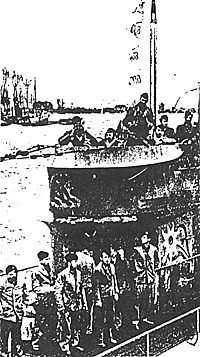 U-124, the EDELWEISSBOOT.
U-124, the EDELWEISSBOOT.
SS CYNTHIA OLSON was the first American Flag merchant ship sunk during World War II by the enemy on December 7, 1941 some 1,200 miles west of Cape Flattery, Washington with 33 merchant crew and 2 US ARMY personnel; no survivors.
(HARRY'S NOTE - CYNTHIA OLSON, formerly named COQUINA, was sunk by the I.J.N. submarine, I-26 under K.K. M. Yokota.)
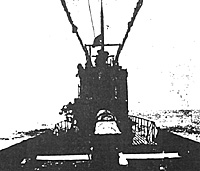 I-26 at sea.
I-26 at sea.
SS BLACK POINT was the last merchant ship sunk in the Atlantic Theater of War on May 5, 1945 with the loss of 11 merchant seamen and one US NAVY ARMED GUARD.
 The Last Photo of SS BLACK POINT.
The Last Photo of SS BLACK POINT.
(HARRY'S NOTE - this old coal ship was sunk by U-853 under Oblt zS Helmut Fromsdorff; U-853 was immediately attacked by a large number of ships and sunk with all hands lost.)
The first WW II ARMED GUARD crew were taken from the regular NAVY in April, 1941 and sent to Little Creek, Virginia to set up and train gunners in the event of war breaking out. These were the first men to man the few guns that were available at that time. The casualty rates were high among the ARMED GUARD at the beginning of WW II due to the fact that the enemy ruled the sea. Because they shipped out with no guns or escort protection, the ships were sitting ducks, for the enemy had very little resistance. Many ARMED GUARD and merchant seamen lost their lives in sight of the American shoreline. The skies were lit up at night off the coast of the Carolinas and it earned the nickname of TORPEDO ALLEY.
World War II brought on a different type of war than the first one.
Back to KTB #108 Table of Contents
Back to KTB List of Issues
Back to MagWeb Master Magazine List
© Copyright 1994 by Harry Cooper, Sharkhunters International, Inc.
This article appears in MagWeb (Magazine Web) on the Internet World Wide Web. Other military history articles articles are available at http://www.magweb.com
Join Sharkhunters International, Inc.: PO Box 1539, Hernando, FL 34442, ph: 352-637-2917, fax: 352-637-6289, www.sharkhunters.com
